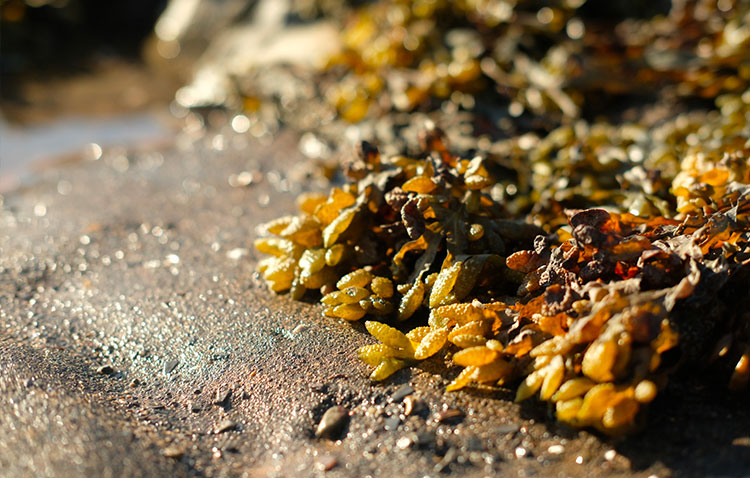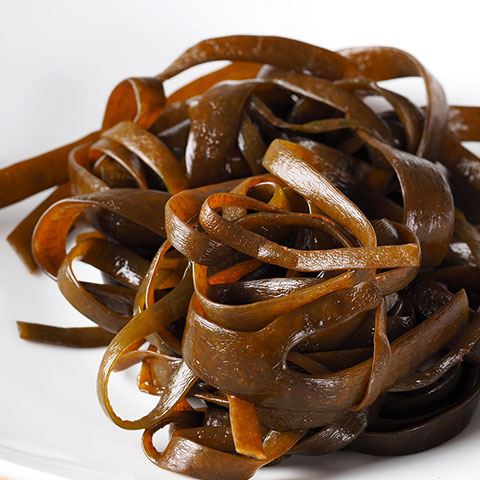
It is the turn of 4 new varieties of algae, sweet seaweed, sea spaghetti, fucus and iziki.
In the previous entry, we initiated and exposed the benefits that seaweed provides to our body, and explained the culinary and therapeutic characteristics of the Agar-Agar, Arame and Cochayuyo algae,
We will continue to expose the immense properties of the most popular algae (algae that we can easily find and add to our diet), given the enormous benefits that we can extract from them.
Below we detail the 4 varieties that this week’s analysis brings us, that of the algae Dulse, Spaghetti de Mar, Fucus and Iziki.
-
DULSE (Rhodymenia palmata)
 Nutrition and Health This seaweed is the most popular marine vegetable in the North Atlantic. The Vikings had a habit of chewing it raw, which could explain that they never suffered scurvy, and even today the Icelanders make snacks with it.
Nutrition and Health This seaweed is the most popular marine vegetable in the North Atlantic. The Vikings had a habit of chewing it raw, which could explain that they never suffered scurvy, and even today the Icelanders make snacks with it.
The Dulse grows abundantly in the turbulent waters of the rocky shores. The plants are small, measure between 15-30 centimeters, and are purple red, with a soft texture and a peculiar spicy flavor.
After Nori seaweed, Dulse is the seaweed that has the highest protein percentage among common algae. It is also rich in calcium, potassium, iodine, phosphorus and iron (its high content makes it an important invigorating blood).
In the kitchen: It is one of the best foods to eat raw, especially if it is incorporated into salads (where it is enough to soak it), in the preparation of soups or as a condiment. Slightly cooked, it combines well with onion, in addition to being a tasty companion for any type of cereal.
In health: Ideal as a restorative in states of asthenia, anemia and postoperative processes. Also indicated in gastrointestinal problems. Useful for lowering blood pressure.
-
SPAGHETTI DE MAR (Himanthalia elongata)
 Nutrition and seaweed This brown seaweed is typical of whitewater, although it is grown and harvested in the North Atlantic. Although it is one of the last algae incorporated into food, it is one of the most personality shows in the kitchen (Guerrero, 2013).
Nutrition and seaweed This brown seaweed is typical of whitewater, although it is grown and harvested in the North Atlantic. Although it is one of the last algae incorporated into food, it is one of the most personality shows in the kitchen (Guerrero, 2013).
It has a high content of iron, phosphorus and potassium, and its taste is reminiscent of sepia. It has even been fermented as sauerkraut.
Due to its high iron content, it is recommended in cases of iron deficiency anemias, as well as when edema and fluid retention are suffered, thanks to its high potassium content.
In the kitchen: It is perfect to be included in cold dishes, leaving it at least 20 minutes to soak before being consumed raw. It is a good alternative for pasta enthusiasts looking for a light and gluten-free alternative. It is very tasty by sautéing it (after hydration) with garlic and parsley and serve it sprinkled with grated cheese. It can also be consumed in salads, breads, fermented, etc.
In health: Improves the absorption of magnesium and calcium, lowers the level of triglycerides in the blood, regulates cholesterol, activates defenses, and cleanses the body, rejuvenating it. Especially indicated for anemias, asthenias and chronic fatigue states.
-
FUCUS (Fucus vesiculosus)
 Under this name a good number of species agglutinates, although the most abundant and habitual in its use is vesiculosus.
Under this name a good number of species agglutinates, although the most abundant and habitual in its use is vesiculosus.
It is a brown seaweed that, popularly, receives the name of Sea Grape, because it shows small balls (vesicles) that contain mucilage, which is an intestinal toning that provides a feeling of satiety.
It exerts a mild laxative action and, above all, it is used to dissolve cholesterol and fight cellulite (Ventura, Rodrigues, Falcão and Alves, 2018). All varieties of Fucus are a good source of iodine.
To understand it better, let’s look at the following data: seawater contains 5 µg per 100 cm3, while Fucus can have up to 12 µg per 100 g. (For this reason, anyone with thyroid disorders should, before consuming it, consult their doctor or specialist). In addition, this seaweed is rich in alginic acid, in mannitol and in vitamins A, B, C and E. Its important curative effects have caused it to be used specifically for the treatment of certain diseases (Agregán, Franco, Carballo, Tomasevic, Barba, Gómez, Muchenje and Lorenzo, 2018).
In the kitchen: Fucus is not an algae commonly used in cooking, but its use is more therapeutic. How to take Fucus? Usually, in the form of infusions or teas, or also in capsule format, as a nutritional supplement, usually associated with weight loss diets. If you choose to take it as an infusion, it can be prepared as a decoction, in a proportion of about 20 or 30 grams per liter of water, boiling about 15 ’and boiling a cold cup before each meal.
In health: Used to combat scrofulism and mumps (mumps). It is very effective in the treatment of goiter, uric acid (gout) and obesity. It is good for skin care, stimulates the thyroid, increases basal metabolism, relieves joint pain, reduces the risk of cancer (as it has fucoidan, known for offering a variety of antitumor and antigiogenic benefits (Neto, Marçal, Queirós, Abreu, Silva and Cardoso, 2018), reduces bad cholesterol and regulates the menstrual cycle.
-
IZIKI or HIJIKI (Cystophyllum fusiforme)
 Nutrition and seaweed The Iziki seaweed grows primarily in the Far East, where they cover the rocks just below the water level, and are shaped like a shrub.
Nutrition and seaweed The Iziki seaweed grows primarily in the Far East, where they cover the rocks just below the water level, and are shaped like a shrub.
Each bush reaches a meter high, more or less, and after collecting it (the harvest is between January and May), they are dried in the sun, being boiled in large freshwater tanks for several hours, so that they are more tender . During this process, they turn black when they reabsorb the concentrated pigment they had expelled in the water and, finally, after the process, their characteristic appearance is black and fibrous (Guerrero, 2013).
An amount of 100 grams of dried Iziki contains more than 1,400 milligrams of calcium (while milk has only 100 milligrams per 100 grams). It is also rich in iron, proteins and vitamins A and B, as well as in trace elements that balance the level of blood sugar, which makes it especially recommended for diabetics (Almela, Jesús Clemente, Vélez and Montoro, 2006).
In the kitchen: It can be eaten boiled or raw. If you opt for the first option, you have to pre-soak it for 25 minutes (so that it increases dry volume five times). It is then rinsed and boiled for at least 30 minutes, since it is a fairly hard seaweed. Once boiled, it can be taken in sauteed vegetables, in soups, as stuffed with empanadillas or cannelloni, in sauces, etc. If it is preferred to take raw, the result is excellent for its delicate flavor and can be incorporated into salads, with cereals and sweetened considerably with onion.
In health: Different studies have shown that this seaweed is a good restorative in processes of anemia, asthenia and postpartum periods, as it provides easily assimilable iron, and good amounts of calcium and other minerals. They are cleansing and strengthen bones, nails and hair, so that in Japan they are reputed to be a good anti-aging treatment. In addition to that, they can help in cases of high blood pressure, constipation, heartburn, and the usual hot flashes of menopause.
References:
Agregán, R., Franco, D., Carballo, J., Tomasevic, I., Barba, FJ., Gómez, B., Muchenje, V. and Lorenzo, JM. (2018). Shelflifestudy of healthy porkliver pâté with added sea weed extracts from Ascophyllumnodosum, Fucusvesiculosus and Bifurcariabifurcata. Food Res Int., 112 (5), 400-411. DOI: 10.1016 / j.foodres. 2018.06.063.
Almela, C., Jesús Clemente, M., Vélez, D., & Montoro, R. (2006). Total arsenic, inorganic arsenic, lead and cadmium contents in edible seaweed sold in Spain. Food and Chemical Toxicology, 44 (11), 1901-1908. Guerrero, R. (2013). How algae heal. Barcelona: RBA Editorial
Net, RT., Marçal, C., Queirós, AS., Abreu, H., Silva, AMS. and Cardoso, SM. (2018). Screening of Ulva rigida, Gracilariasp., Fucusvesiculosus and Saccharinalatissima as FunctionalIngredients. Int J Mol Sci., 30 (2), 10-19. DOI: 10.3390 / ijms19102987.
Ventura S, Rodrigues M, Falcão A, Alves G. (2018). Safety evidenceontheadministration of Fucusvesiculosus L. (bladderwrack) extract and lamotrigine: data frompharmacokineticstudies in therat. DrugChem Toxicology, 18 (3), 1-7. DOI: 10.1080 / 01480545.2018.1518454.



